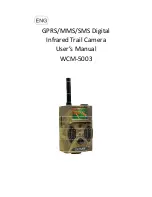Developing Software for the PL-A780
43
PixeLINK PL-A780
Document No.: 04646-01
MACHINE VISION CAMERA
SYSTEM GUIDE
Copyright © 2004 PixeLINK
All Rights Reserved
features a specific camera supports and the Control registers are used to modify settings of
the supported features. The next section will go into more detail about some of these
registers.
6.5 Command Register Details
This section will give details on some of the different IIDC command registers, what they
mean and how to use them.
6.5.1 Video Formats
IIDC video formats are used to define what type of video data will be output from the camera.
Several different formats are defined based on image size:
•
Format 0 – VGA (640x480) and smaller resolutions
•
Format 1 – SVGA format 1 (from 800x600 to 1024x768)
•
Format 2 – SVGA format 2 (from 1280x960 to 1600x1200)
•
Format 6 – Still Images (not described in this document)
•
Format 7 – Scalable image size (user defined size and position)
For each video format there are several defined modes. The mode specifies the exact size of
the video data and the size and color information of the pixels (i.e. Mono 8-bit, YUV422 16-
bit, etc.)
A given camera will only support some of the video formats and some of the modes for the
supported video formats. One of the first things controlling software should do is determine
which formats and modes are supported.
The IIDC specification defines the Inquiry Registry for Video Format. This register can be
read from offset
0100h
(or address
FFFF F0D0 0100h
using the example IIDC base
address) and the value will indicate which formats are supported.
The IIDC specification defines the Inquiry Registers for Video Modes. There is a register for
each video format. If format 1 is supported then the register at offset
0184h
(or address
FFFF
F0D0 0184h
) can be read to determine which modes are supported for format 1.
6.5.1.1 Formats 0, 1 & 2
For formats 0, 1 & 2 there are also pre-defined frame rates for each video mode. The IIDC
specification defines the Inquiry Registers for Video Frame Rates. There is a separate
register for each video mode. Read the registers for the supported video modes to determine
which frame rates the camera supports.
6.5.1.2 Format 7
Format 7 is very flexible, allowing the user to specify the width, height, position and pixel
format of the video data. A separate set of control registers exists for each format 7 mode. To
determine the location of these control registers for a given mode the offset can be read from
registers starting at offset
02E0h
. For example, to determine the control register offset for
format 7 mode 0 read the register at offset
01E0h
(or address
FFFF F0D0 01E0h
), if this
value was
0034 0280h
then the offset for the control registers would be
00D0 0A00h
(or
address
FFFF F0D0 0A00h
). Note that this offset is relative to the base address
FFFF F000
0000h
not the IIDC base address.
The format 7 control registers, as defined in the IIDC specification are mostly self-
explanatory. They provide information on the sizes and positions of video data supported, the


















